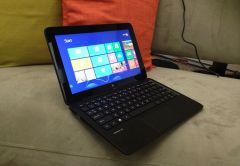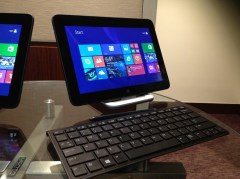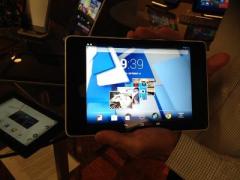As PC sales plummet, HP is trying everything to regain some footing.
On Thursday, HP announced three Windows 8 hybrids with detachable touchscreens, one Windows 8 tablet, and four Android tablets for the U.S. market. They’re all coming in October and November.
Here’s a rundown:
HP Spectre 13 x2 (pictured above): It’s a 13-inch laptop whose touch screen detaches from the keyboard and trackpad dock. Unlike other PCs that use Intel’s fourth-generation Core processors (codenamed Haswell), this is the first with no fans or vents. It has a 1080p display, at least 4 GB of RAM and up to 7.5 hours of battery life for the tablet section alone. When combined with the laptop dock, battery life jumps to 10 hours, but it also becomes somewhat heavy for its size at 4.4 pounds, according to Laptop Mag. The Spectre 13 x2 launches on October 16 for $1,100.

HP Pavilion 11 x2 (pictured): Somewhat of a sequel to HP’s Envy X2 hybrid from last year, the Pavilion 11 x2 upgrades to Intel’s Bay Trail processor and 4 GB of RAM. The 11.6-inch touch screen detaches from the base to become a tablet. On the downside, screen resolution is unchanged from last year, at 1366-by-768, and HP is going with a plastic shell instead of aluminum. It’ll be out November 17 for $600.
HP Pavilion 13 x2: It’s not just a 13-inch version of the aforementioned Pavilion. This one has a choice of AMD A6 or Intel Haswell processors, and the option to stuff a 500 GB hard drive in the keyboard dock. Again, it’d be nice to see a higher resolution than 1366-by-768, and like the 11-inch model, pricing will start at $600 with a November 17 release date.

HP Omni 10 (pictured): No fancy hybrid designs here, just a standalone 10-inch Windows 8 tablet with a 1920-by-1200 resolution display, Intel Bay Trail processor, 2 GB of RAM and a 9-hour battery. It also comes with Microsoft Office 2013, so it’d be great to see a laptop dock for this one, but apparently it’s not happening. No word on pricing yet, but it’s coming out in November.
HP Slate 7 Extreme: What’s so extreme about it? Not sure, but It’s a 7-inch Android tablet with a 1280-by-800 resolution display, Nvidia Tegra 4 processor, front-facing speakers and a stylus. Look for it in November, price TBA.

HP Slate 8 Pro (pictured): This is HP doing its best iPad Mini impression, with an 8-inch tablet at 1600-by-1200 resolution, CNet reports. It’s the same the 4:3 aspect ratio found in all iPads, but it’s a rarity in Android tablets. Other specs include a Tegra 4 processor and 2 GB of RAM, but no word yet on whether it’ll undercut Apple’s tablet on pricing. We’ll find out in November.
HP Slate 7 HD: As we reach the low end of HP’s tablet line, the Slate 7 HD has a 1280-by-800 resolution screen, a dual-core Marvell chip and 1 GB of RAM. The interesting thing here is that HP will offer 200 MB per month of T-Mobile 3G data for two years, built into the price. We won’t know what that price will be, however, until November.
HP Slate 10 HD: It’s the same exact specs as the 7-inch model, with the same T-Mobile data, but on a 10-inch display. It’s also coming in November for a yet-to-be-named price.
The strategy reminds me somewhat of Lenovo’s approach from 2012, when the company seemed to be trying every possible combination of Windows 8 hybrids, along with a range of Android slates. (Lenovo, incidentally, overtook HP this year to become the world’s top PC vendor according to Gartner.) The main difference is that HP seems bullish on the detachable hybrid, while Lenovo is just as interested in convertible devices like the IdeaPad Yoga, in which the keyboard portion stays attached.
The end of the year is starting to look pretty busy for far-out designs from PC makers, including detachable and convertible designs that roll the tablet and laptop into one. Although I previously worried that PC makers would try and play it safe with their designs in light of Microsoft’s sluggish Surface sales, the opposite has become true. For all the PC industry’s woes, experimentation turns out to be a positive side effect.

